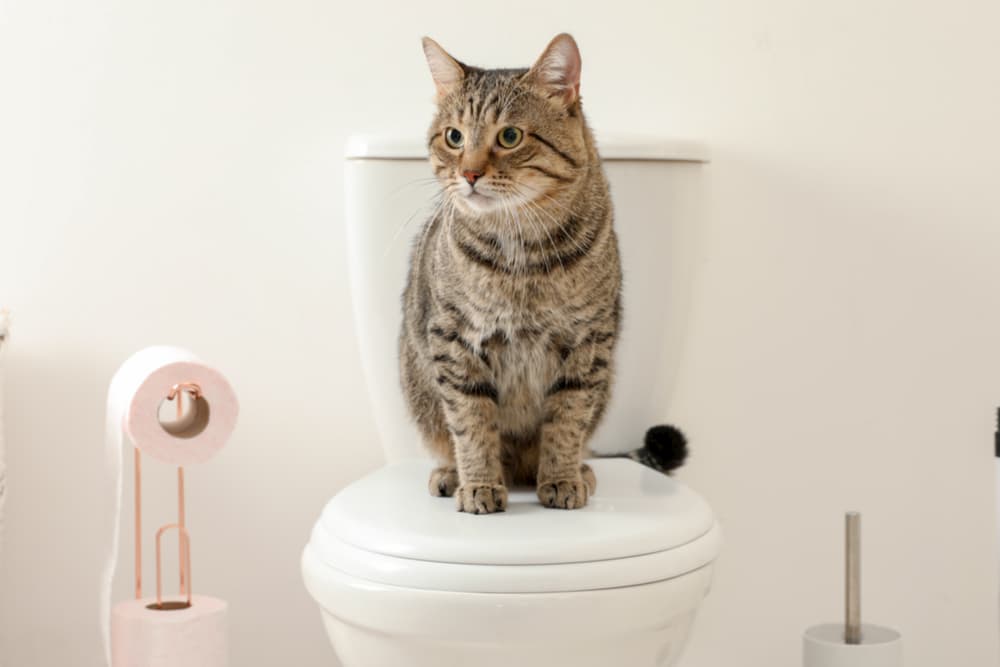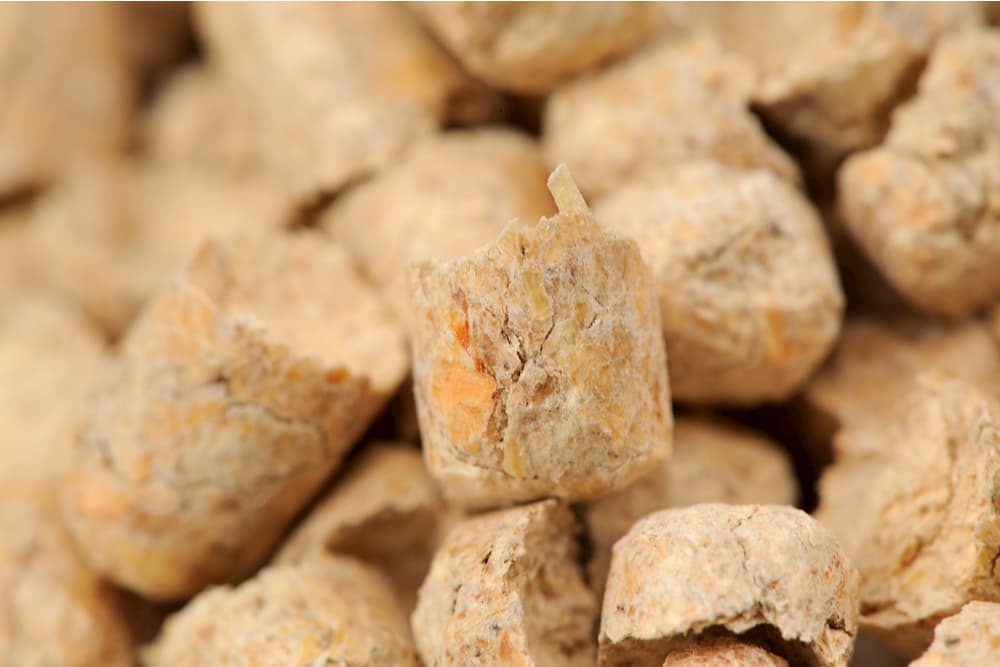Flushable Cat Litter: Weighing the Pros and Cons

Let’s be honest—no one likes cleaning the cat litter. Inhaling the pungent odor, sweeping up small granules of litter that skitter across the floor, and hauling a heavy plastic bag filled with waste out to the bin might be one of the least appealing parts of cat parenthood.
Despite the ick factor, cat owners spend $3.9 billion on litter products every year. Manufacturers have developed all manner of products to help make cleaning the cat litter less cringe-worthy from “scoopable” cat litter and litter box liners to deodorizers and self-cleaning litter boxes. But the availability of flushable cat litter is also expanding.
Between 1 and 3 percent of cat owners report purchasing cat litter made from flushable products such as wheat, newspaper, corn, and wood shavings, according to a recent American Pet Products Association report.
“Pet owners are demanding more eco-friendly products and companies are responding to that,” says Dr. Jami-Lyn Derse, veterinarian and founder of Veterinary Housecall Care in Chicago. “A lot of these flushable cat litters are made from more eco-friendly materials.”
Flushable cat litter is touted as a more convenient and sustainable option than conventional clumping litters that must be bagged and tossed in the trash—but is it worth the extra cost?
What Is Flushable Cat Litter?

Flushable cat litter is made from biodegradable materials that break down in the environment. It will not harden when mixed with water and is supposed to be safe to flush down the toilet.
Conventional cat litter is often made from a combination of clay and silica. The granules in clay-based cat litter harden and expand when they get wet, giving it a concrete-like consistency. It might make the litter box easier to clean but it could clog the pipes and wreak havoc on the plumbing if pet parents attempt to dispose of it in the toilet.
Clay and silica-based litters are also mined, which could lead to environmental damage (1). But flushable cat litters are made from sustainable materials such as shredded newspaper, sawdust, corn kernels, walnut shells, or wheat enzymes. Most mainstream retailers stock flushable kitty litter.
Types of Flushable Cat Litter

All flushable litter for cats is made from biodegradable materials. Some manufacturers make their litter from a single material while others use a combination of materials in their biodegradable flushable litter. Here are a few of the most common materials used in flushable cat litter:
Corn
Natural compressed corn, whole kernel corn, or corn pulp are among the top products used in flushable cat litter brands. Manufacturers tout them as natural, biodegradable materials.
Wheat
This common agricultural crop is also used in cat litter. Like corn, it is hailed as a biodegradable, renewable material. When moisture is added to the starches in wheat, it clumps, making it easier to scoop.
Wood Products
Some brands of flushable litter are made from sawdust, shavings, and other reclaimed wood (that has not been treated with chemical sealants). Thanks to the natural deodorizers and fresh scents of woods like pine and cedar, cat litter products made from recycled wood claim to eliminate odors.
Shredded Paper
Paper is pressed into soft pellets to make flushable cat litter. Manufacturers often use post-consumer paper to ensure the product is sustainable. Baking soda is often added to the lightweight litter to help with odor control.
Pros of Flushable Cat Litter

When it comes to cat litter, flushable brands made from sustainable materials offer two big benefits over conventional cat litters.
Sustainability
The search for a “greener” alternative to conventional cat litter is one of the biggest reasons cat owners consider flushable cat litter, according to Derse.
The clay used in conventional cat litter is collected through a process called strip mining that removes the top layer of soil and rock to access clay, affecting ecosystems and polluting waterways. In contrast, flushable cat litter is made from products that are biodegradable or renewable.
Flushable cat litter is more environmentally friendly even if you bag it (in a paper or biodegradable bag) and send it to the landfill instead of flushing it down the toilet.
Convenience
Flushing litter down the toilet might be easier than scooping it into a bag and disposing of it in the trash, especially for cat owners with litter boxes in the bathroom or whose outdoor trash receptacles are not easily accessible, says Dr. Lori M. Teller, clinical associate professor in the College of Veterinary Medicine and Biomedical Sciences at Texas A&M University.
“It’s mostly about convenience,” she explains.
Cons of Flushable Cat Litter

Flushable cat litter might be a more sustainable, convenient option but it also has several drawbacks.
It Doesn’t Clump Easily
A whopping 63 percent of cat owners choose litter that is clumping or scoopable, according to the APPA report—and for good reason, according to Teller.
“You can scoop stool, but it’s much harder to scoop urine if it’s not clumping,” she says. “It makes it harder to clean.”
Cat litter that clumps could clog the pipes, which means that flushable cat litter was designed not to clump and that can make it messier or more difficult to clean up.
Animal Health Concerns
Some of the products used to make flushable cat litter, including corn and wheat, are common allergens. If you are allergic to these products and handle corn-or wheat-based cat litter, it could cause a reaction. Read the ingredient label carefully.
Cat feces can also contain toxoplasma, an illness-causing parasite that can be passed to humans. A growing number of marine mammals have been diagnosed with toxoplasmosis, which is believed to have survived the sewage treatment process, allowing cat litter flushed down the toilet to sweep the parasite out to sea.
Plumbing Concerns

Even though it was designed to be flushed down the toilet, flushable cat litter can still cause clogs. Septic systems, in particular, were not designed to handle the extra solids from flushable cat litter and can struggle (or fail) to break down in the septic system. Flushing pet waste may also exceed the design capacity of the septic system.
“Older systems are more fragile and newer toilets flush lower volumes of water,” Teller says.
Because of this, Teller recommends flushing one or two clumps at a time rather than emptying the entire contents of the litter box into the toilet. But, with each flush, your water use goes up and the environmental benefits go down—and it takes longer to clean the litter box.
Higher Cost
Flushable cat litter tends to be more expensive than conventional clay-based clumping cat litter. Although each bag might cost just a few dollars more, it can add up over the life of your cat.
Should You Really Flush Cat Litter?

The cat litter might be labeled “flushable” but that doesn’t mean it’s safe to send it down the toilet to the wastewater treatment plant. In fact, some state governments, including Rhode Island, prohibit pet owners from flushing pet waste.
The California legislature even passed a bill that requires flushable cat litter manufacturers to add a statement to their packaging that discourages cat owners from flushing cat litter down the toilet.
And as previously mentioned, even flushable litters can cause plumbing and septic tank issues—but that doesn’t mean flushable litter is a bad idea.
“The main reason a litter is eco-friendly is because of the [materials in the] litter, not how you dispose of it,” Derse says. “There are excellent ‘flushable’ litter products out there that can go into the garbage can and go to the landfill to biodegrade.”
How to Switch Cat Litters

Switching to flushable cat litter is not as simple as purchasing a bag and filling the litter box.
“Cats are really finicky,” Derse says. “Some will go into the litter box and use [new litter] with no problem, but some will go outside the box.”
For a smooth transition, Derse advises placing multiple litter boxes around the house and filling one with the old litter and one with the new, flushable product to see how the cat responds. If the cat avoids that litter box with the flushable litter altogether, your feline might never adapt. Consider experimenting with a different brand (or ingredient mix) of flushable litter to see if there is one your cat prefers.
Over time, mix in ever-increasing amounts of flushable litter in with the old litter so the change is gradual.
“You have to go slow and almost trick them into using it,” Derse says.









